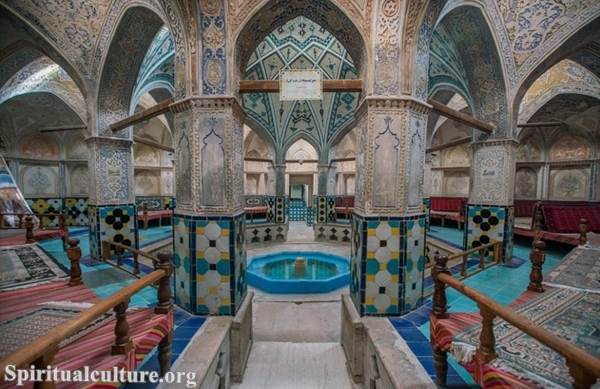The culinary landscape of Qatar is a deep reflection of its history, blending the resourcefulness of Bedouin traditions with the rich spice trade influences of the Arabian Gulf. More than just sustenance, Qatari food embodies the central spiritual and cultural values of hospitality, community, and generosity. As of the Current Time of Writing, these traditional dishes continue to anchor celebrations, family gatherings, and the breaking of the fast during the holy month of Ramadan, preserving ancient preparation methods and treasured family recipes.
A true understanding of Qatari culture begins at the communal table. The subtle use of ingredients like dried lime (loomi), saffron, cardamom, and the ever-present date, transforms simple grains and meats into profound cultural narratives. This Top 10 guide dives beyond mere popularity, explaining the spiritual and social impact of each dish, demonstrating why they remain essential cornerstones of the Qatari way of life.
At Spiritual Culture, we celebrate these gastronomic masterpieces not just for their flavour, but for the profound heritage they carry. The following ranking is based on each dish’s cultural significance, historical prevalence in traditional ceremonies, and its enduring role in modern Qatari social life and communal dining etiquette.
Table of the Top 10 Most Popular Qatari Foods by Cultural Significance
| Rank | Dish Name | Cultural Category | Spiritual Significance (Primary Context) |
|---|---|---|---|
| 1 | Machboos (Qatari Kabsa) | National/Celebration Main Dish | Symbol of Generosity and Grand Hospitality, central to all major gatherings (e.g., Eid, weddings). |
| 2 | Harees | Fasting/Nourishment Porridge | A traditional Iftar dish during Ramadan, symbolizing humility, simplicity, and compassion. |
| 3 | Thareed | Prophetic/Communal Stew | Believed to be a dish favoured by the Prophet Muhammad; associated with Ramadan Iftar and charitable giving. |
| 4 | Luqaimat | Festive Dessert | Golden, sweet dumplings traditionally made for Eid and Ramadan to celebrate the breaking of the fast. |
| 5 | Dates (Tamr) | Staple & Symbol of Hospitality | A foundational food for breaking the fast (Sunnah); a universal symbol of Welcoming Guests and resilience. |
| 6 | Balaleet | Sweet & Savory Breakfast | A festive breakfast dish, particularly popular during Eid celebrations, embodying the balance of life. |
| 7 | Madrouba | Comfort/Winter Porridge | Hearty rice porridge, valued for its nourishing and easily digestible quality, often consumed during Ramadan and cold months. |
| 8 | Ghuzi (Shuwaa) | Feasting Centrepiece | A whole roasted lamb over rice, reserved for the grandest feasts and state occasions, signifying ultimate honour. |
| 9 | Saloona | Daily & Shared Stew | A simple, versatile, homemade stew reflecting the Bedouin tradition of resourcefulness and daily familial unity. |
| 10 | Regag Bread | Traditional Staple/Street Food | A thin, crepe-like bread, fundamental for soaking up stews (like Thareed) and symbolising the basic staple of the Qatari table. |
#10. Regag Bread
Regag is a delicate, paper-thin crepe-like flatbread, a foundational carbohydrate in Qatari cuisine, prepared by spreading a liquid batter over a large, hot metal griddle. Its simplicity and utility have made it a ubiquitous presence, easily found in both traditional homes and bustling street food stalls, such as those in Souq Waqif, where it is often cooked fresh before your eyes. Historically, the swift cooking method over fire reflects the necessary efficiency and simple ingredients available in the nomadic Gulf environment, emphasizing the value placed on essential, unadorned staples in the local diet, even as of the Current Time of Writing.

The spiritual impact of Regag lies in its humble adaptability; it is the perfect vehicle for more complex dishes. When used to line the bottom of a Thareed pot, it readily absorbs the rich, nourishing broth of the meat and vegetables, embodying the concept of taking in the blessings of the community meal. It represents the supporting base of the Qatari culinary tradition—necessary, versatile, and deeply respected for its role in making other, more celebratory dishes complete.
This thin bread reminds us that true cultural heritage often resides in the simplest things. Its function as a universal wrap for fillings, from cheese and egg to date syrup, shows a resourcefulness that is a powerful moral lesson: value the simple, fundamental elements of life, for they are what enable the greater feast. Its preservation value rests in its unbroken chain of preparation, a culinary act connecting modern Qatari life directly to its desert past.
Cultural/Spiritual Highlights
- Fundamental staple, serving as a base for stews like Thareed.
- Its simple recipe reflects historical Bedouin resourcefulness.
- Often topped with local honey or date syrup for a quick, sweet treat.
#9. Saloona
Saloona is a classic, hearty Qatari stew composed of meat (typically lamb, chicken, or fish) and seasonal vegetables, all simmered in a fragrant, often spicy, tomato-based broth. Its popularity stems from its adaptability, as a cook can literally use whatever ingredients are available, making it the ultimate home-style dish. This dish is a daily feature in Qatari households, providing a comforting and balanced meal that is typically eaten with rice or bread, maintaining its central role in weeknight family dining as of the Current Time of Writing.

The spiritual significance of Saloona rests in its domesticity and the value of shared, simple sustenance. It is not a feast dish but a dish of familial unity, representing the core Islamic value of providing for and sharing with one’s household. The slow simmering of diverse ingredients together into a single, flavourful broth symbolises the family unit—different elements coming together to create a unified, warm, and nourishing whole, reinforcing the bond around the daily dinner table.
The moral lesson of Saloona is that greatness is not required for goodness. It champions resourcefulness and practical love, showing that the most comforting and spiritually satisfying meals are often those prepared with simple ingredients and shared in the most intimate setting. Its preservation ensures that the Qatari tradition of using locally available resources, adapting to seasons, and sharing simple kindness remains intact.
Cultural/Spiritual Highlights
- A versatile, daily-consumed family stew, reflecting unity.
- Emphasises the cultural value of simplicity and resourcefulness.
- Often seasoned with local spices like ginger, garlic, and turmeric.
#8. Ghuzi (Shuwaa)
Ghuzi, also known as Shuwaa, is not a daily meal but a magnificent centrepiece—a whole roasted lamb or goat served majestically atop a bed of richly spiced rice, often garnished with nuts and raisins. This dish is the ultimate expression of Qatari feasting culture and generosity. Due to its size and complexity, it is exclusively reserved for the grandest occasions, such as major national holidays, significant weddings, and honouring state-level guests, ensuring its status as a high-value cultural identifier as of the Current Time of Writing.

In terms of spiritual impact, Ghuzi is a profound demonstration of ultimate hospitality, an act of sacrificial generosity that honours the guest far above the effort required. It connects directly to Bedouin traditions where a host would slaughter the best animal to welcome visitors, reflecting the Islamic principle of lavish hospitality (Dayf). Serving an entire roasted animal symbolises abundant blessings, wealth, and the deepest respect the host can bestow upon the assembled community or guest of honour.
The reflection offered by Ghuzi is the principle of abundance in giving. It teaches that one should always strive to give one’s best when welcoming others, a moral code deeply ingrained in Gulf culture. The effort required for its preparation and the sheer volume of food demand communal preparation and sharing, reinforcing the societal structure of reciprocal generosity and shared celebration.
Cultural/Spiritual Highlights
- Ultimate expression of Qatari hospitality (Dayf).
- Reserved exclusively for the grandest celebrations and honouring VIPS.
- Involves slow roasting a whole animal, requiring immense communal effort.
#7. Madrouba
Madrouba is a nourishing, savoury rice porridge that stands apart from Machboos by its smooth, creamy consistency, achieved by simmering it for hours with chicken or fish, milk, butter, and a blend of aromatic spices until the ingredients are essentially mashed together. This soft, easily digestible quality makes Madrouba a staple comfort food, particularly cherished during the cool winter months and for those needing restorative nutrition. As of the Current Time of Writing, it remains a common dish served during the fasting month of Ramadan for a gentle Iftar.

The spiritual significance of Madrouba is linked to its comforting, restorative nature. Much like the simple Harees, it symbolises humility and is perfectly suited for breaking a fast, gently easing the body back into eating. Its mushy, homogenous texture metaphorically represents the blending of the community into a shared state of nourishment and peace. The long, slow cooking process is an act of patient devotion, mirroring the spiritual commitment required during fasting and prayer.
The moral lesson of Madrouba is found in the wisdom of simplicity and restorative care. It teaches that life’s greatest comforts often come in the most unpretentious forms, focusing on nutrition and gentle sustenance over opulence. The preparation, which requires constant stirring (the meaning of the name), reinforces the value of consistent effort and patient dedication to one’s family and community well-being.
Cultural/Spiritual Highlights
- Creamy, soothing rice porridge, often eaten during cold months and Ramadan.
- The name literally means “beaten,” referring to the necessary smooth texture.
- Symbolises gentle sustenance and physical restoration after a fast.
#6. Balaleet
Balaleet is a unique Qatari dish that beautifully balances sweet and savoury, consisting of vermicelli noodles cooked with sugar, saffron, rose water, and cardamom, and then traditionally topped with a thin, plain omelette. Primarily a breakfast staple, its striking contrast of tastes makes it a celebratory meal, especially during the days of Eid al-Fitr and Eid al-Adha. As of the Current Time of Writing, it is a favourite morning dish at family gatherings, signalling a festive start to the day.
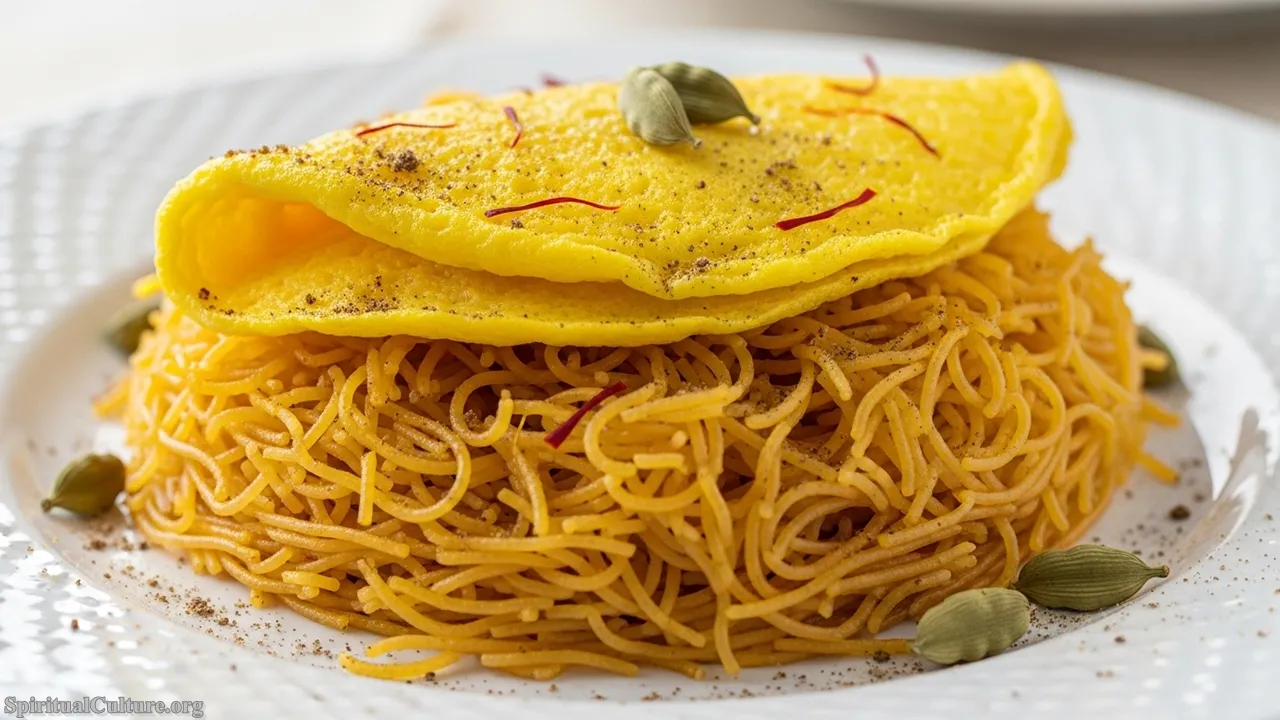
The spiritual impact of Balaleet is tied directly to the celebratory spirit of Eid. The sweetness of the noodles, infused with precious saffron and rose water, represents the joyous end of the fasting period and the blessings bestowed upon the family. The topping of the simple, savoury egg provides a necessary grounding element, symbolising the balance (Mizan) required in all aspects of life—spiritual devotion must be balanced with worldly responsibilities, and celebration with gratitude. This duality makes it profoundly significant.
The reflection of Balaleet is the appreciation of life’s dualities. It teaches us that sweetness is best enjoyed when juxtaposed with substance, and that true pleasure comes from harmony. Its vibrant colour and aromatic spices celebrate the richness of the Qatari spice trade heritage, reminding the community of the blessings derived from their history and geographic fortune, all while reinforcing the convivial atmosphere of the morning family table.
Cultural/Spiritual Highlights
- Sweet vermicelli topped with a savoury omelette, representing balance.
- Essential breakfast dish served during both Eid holidays.
- Flavoured with high-value saffron and rose water, referencing trade history.
#5. Dates (Tamr)
Dates, or Tamr, hold an unparalleled place in Qatari culture, transcending their role as mere food to become a national symbol of hospitality, resilience, and wealth. Harvested from the prolific date palm, they have been a reliable staple in the arid Gulf region for millennia. As of the Current Time of Writing, serving fresh dates alongside traditional Arabic coffee (Qahwa) is the mandatory, non-negotiable first gesture offered to any guest in a Qatari home or public Majlis (sitting room).
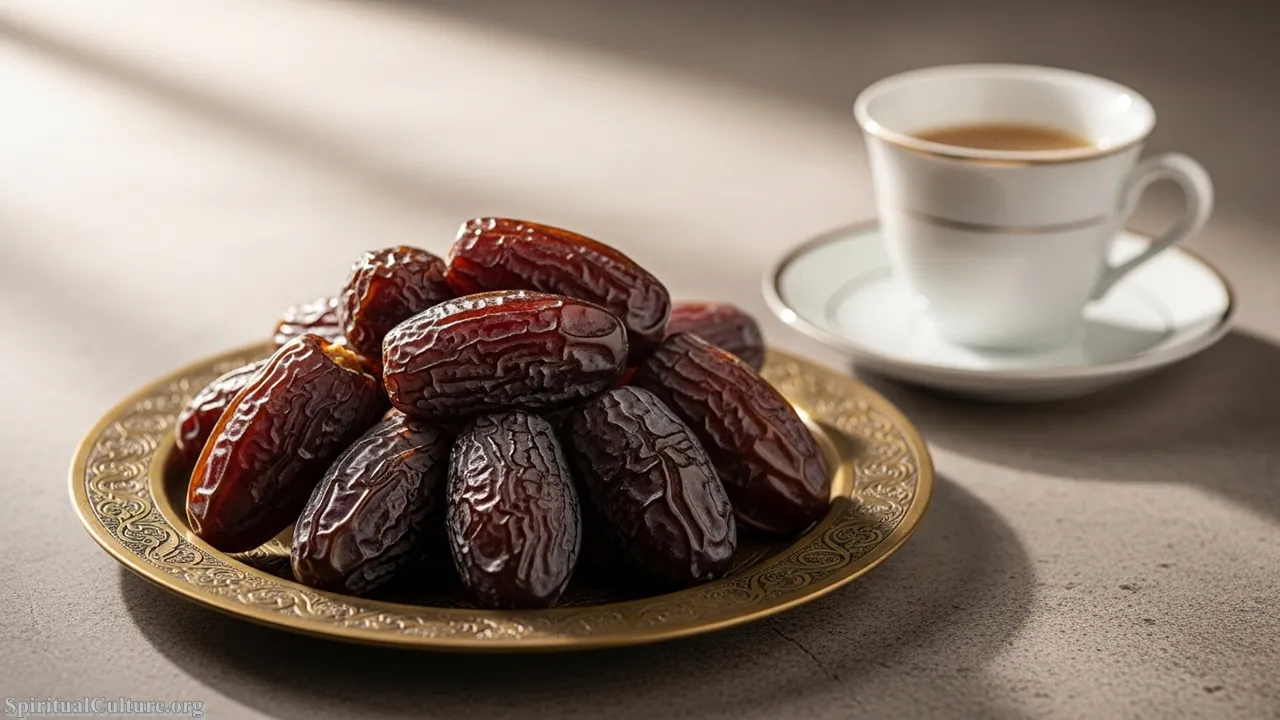
The spiritual significance of dates is foundational, rooted deeply in Islamic tradition. The Prophet Muhammad recommended breaking the fast with dates, making them central to the Iftar meal during Ramadan (Sunnah). They symbolise sustenance and the blessings of the earth, providing immediate, natural energy. Offering dates to guests is a potent cultural act of generosity and welcome, creating an instant bond of respect and shared blessings between host and visitor, invoking a sense of spiritual peace and acceptance.
The moral lesson of the date is one of resilience, patience, and blessing. The date palm, which thrives in harsh desert conditions, teaches that beauty and sustenance can emerge from the most challenging environments. Furthermore, the universal practice of sharing dates first reinforces the value of giving one’s finest resources—a gesture that puts the guest’s comfort and honour above all else, embodying the profound cultural ethic of Spiritual Culture.
Cultural/Spiritual Highlights
- National fruit, revered as a primary symbol of Qatari Hospitality.
- Essential to the Sunnah tradition of breaking the fast during Ramadan.
- Mandatory first offering alongside Arabic coffee in a Qatari home.
#4. Luqaimat
Luqaimat, meaning “small bites,” are golden, crispy, deep-fried dumplings of leavened dough, infused with cardamom and saffron, and generously drizzled with date syrup or honey upon serving. This dessert is one of the most beloved sweet treats across the Gulf, with the Qatari version being particularly famous for its light, airy texture and rich spice notes. Luqaimat is inextricably linked to celebration, appearing most frequently during Ramadan and Eid, where it is shared as a sweet end to the evening meal.

The spiritual impact of Luqaimat is rooted in the celebratory release after a period of spiritual discipline. Served after the fast, their sweetness is a joy-filled reward and a metaphor for the sweet blessings received through piety. They symbolise communal happiness and indulgence, but the small, bite-sized portions maintain an element of moderation and sharing, ensuring the celebration remains communal and mindful of the less fortunate, upholding core Islamic spiritual values.
The reflection of Luqaimat is a joyful reminder of the importance of sharing moments of simple pleasure. Their communal preparation—often made in large quantities to be distributed to family and neighbours—reinforces the cultural value of social cohesion and generosity. They are a taste of heritage, linking the modern celebration back to the historical festive traditions of the Arabian Peninsula.
Cultural/Spiritual Highlights
- Traditional Ramadan and Eid dessert, symbolising sweet celebration.
- Deep-fried dumplings generously coated in local date syrup.
- The name means “small bites,” emphasising their shareable, communal nature.
#3. Thareed
Thareed is an ancient and immensely symbolic dish often described as the “Arabian Lasagna” or a pot stew, composed of slow-cooked lamb or chicken, tender vegetables like potatoes, carrots, and squash, served over layers of thin Qatari bread (Regag). The bread soaks up the rich, spiced broth, becoming a soft, flavourful component of the stew. Thareed’s cultural standing is immense, specifically because it is highly associated with the Iftar table during the holy month of Ramadan, showcasing its role in spiritual life.
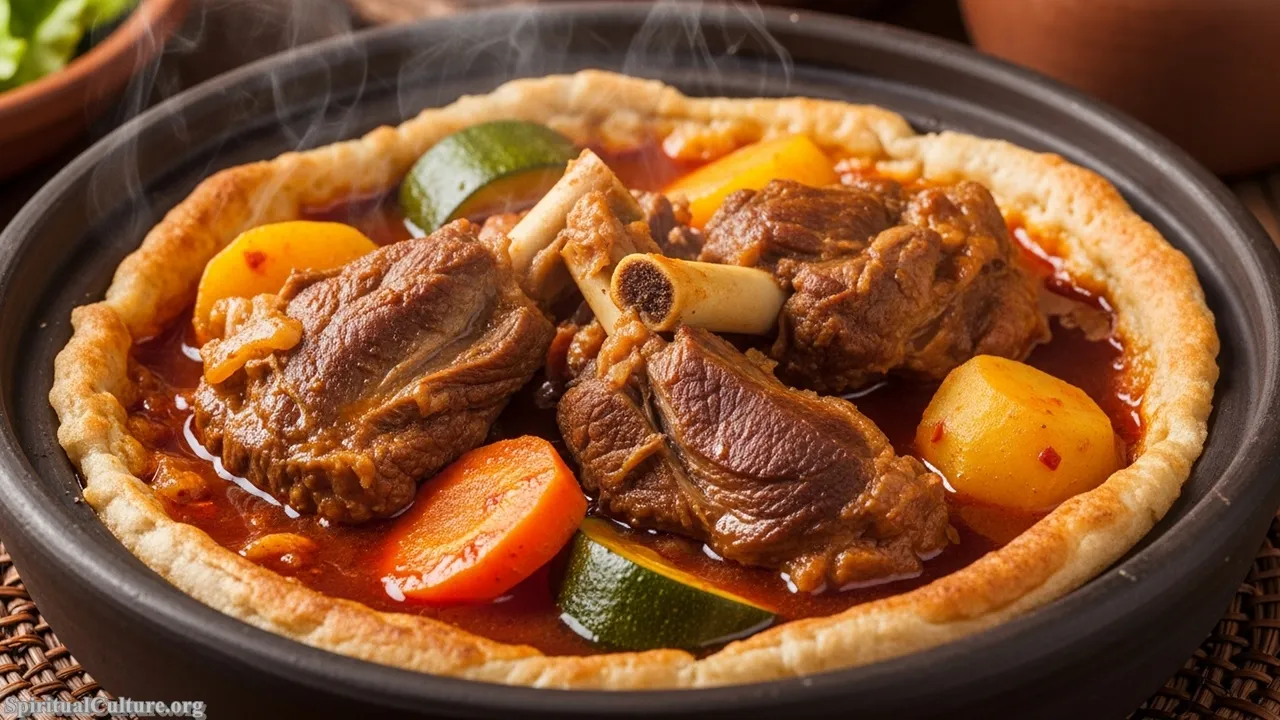
The profound spiritual significance of Thareed stems from its reported preference by the Prophet Muhammad, elevating it beyond mere cuisine into a dish of spiritual reverence and historical weight. This association makes serving Thareed during Iftar not only a culinary choice but a meritorious act, linking the community directly to the actions of the Prophet (Sunnah). The dish’s components—meat, vegetables, and bread—are layered together, symbolising the spiritual integration of life’s various elements and the communal blending of resources to create nourishment.
Thareed offers a deep moral lesson in charity and remembrance. It is a hearty meal designed to feed many, embodying the principle of sharing and care for the less fortunate, a core tenet of Ramadan. The tender, easily consumed nature of the broth-soaked bread is gentle on a stomach that has been fasting, acting as a humble and considerate act of nourishment for the body and soul, a powerful reflection for Spiritual Culture readers.
Cultural/Spiritual Highlights
- Highly revered dish, historically favoured by the Prophet Muhammad (Sunnah).
- A staple and iconic food served at the Ramadan Iftar meal.
- The bread absorbs the broth, symbolising the spiritual absorption of nourishment.
#2. Harees
Harees is a venerable and time-honoured dish made from cracked or coarsely ground wheat that is slow-cooked for many hours with meat (usually lamb or chicken), water, and a touch of salt until it achieves a smooth, porridge-like consistency. It is traditionally finished with a drizzle of clarified butter (ghee) or local spices. Harees is not an everyday dish; its intensive, prolonged preparation makes it a food of celebration and spiritual observance, reserved for Eid, weddings, and, most prominently, as a key component of the Ramadan evening meal as of the Current Time of Writing.

Its spiritual significance is rooted in its role during Ramadan. Harees is one of the most essential meals for Iftar, valued for its nourishing density that provides slow-releasing energy after a day of fasting, while being gentle on the stomach. It symbolises simplicity, patience, and the unity of the community. The long process of beating the ingredients into a smooth mash reflects the commitment and patience required in spiritual devotion, creating a humble, yet satisfying dish that embodies the humility and equality of the Muslim community gathering to break their fast.
The reflective value of Harees is profound, teaching that the greatest rewards often require the longest effort. The commitment to its laborious preparation is an act of love and respect for those who will consume it. It reinforces the ethical lesson that basic, simple ingredients, when handled with dedication and care, can produce a comforting, spiritually rich meal that binds families and friends together through shared heritage and sacrifice.
Cultural/Spiritual Highlights
- A labour-intensive porridge, central to Ramadan and Eid feasts.
- Symbolises humility, patience, and nourishment after fasting.
- Made from wheat and meat beaten to a smooth, unifying consistency.
#1. Machboos (Qatari Kabsa)
Machboos, often referred to as the national dish of Qatar, is a fragrant and elaborate rice dish cooked with tender, slow-cooked meat (chicken, lamb, or sometimes local fish like Hammour) and a rich blend of spices known as Bizar and dried lime (Loomi). This dish is the undisputed king of the Qatari table, serving as the cultural centrepiece for all significant life events, from welcoming a distinguished guest to celebrating a family milestone. Its preparation and presentation are highly ritualistic, solidifying its status as the most popular and culturally significant food as of the Current Time of Writing.
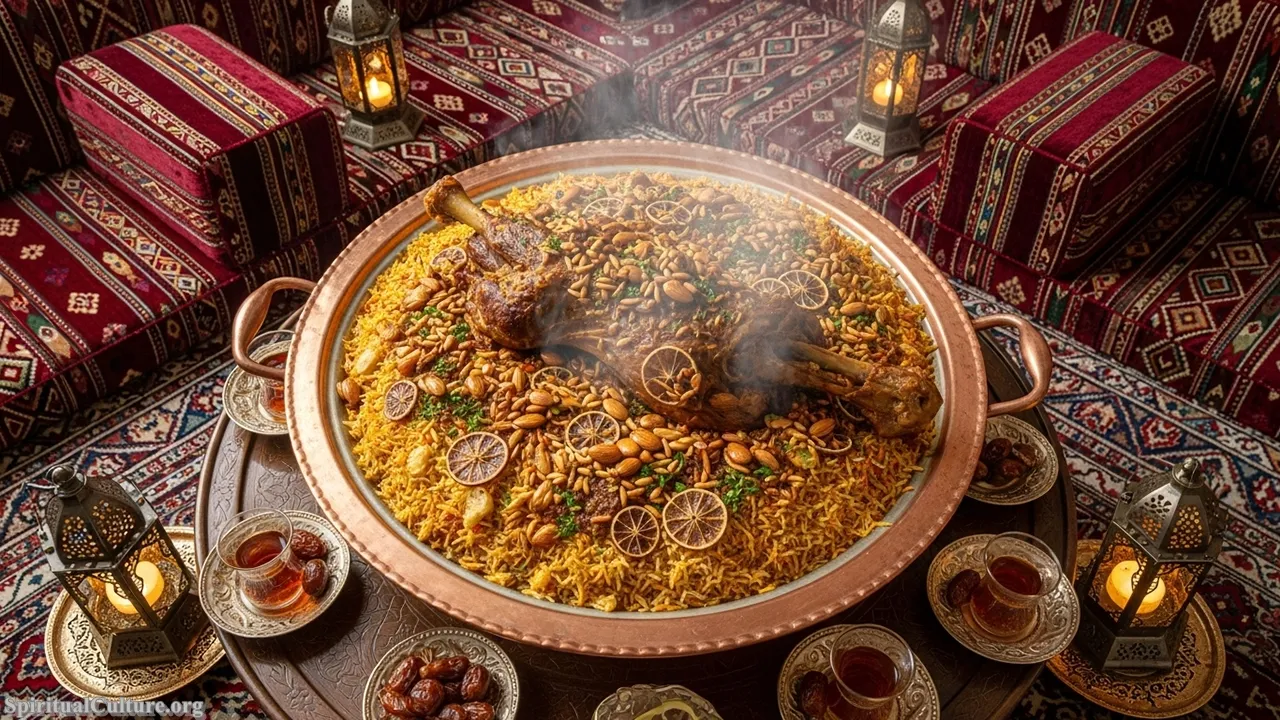
Machboos’s supreme spiritual impact lies in its role as the ultimate Symbol of Generosity and Hospitality. It is the dish a Qatari household prepares when they wish to confer the highest honour upon their guests or to celebrate a communal blessing. Served communally from one large platter, it physically enforces the Islamic and Bedouin value of collective sharing and unity (Al Majlis). The warm, complex spices and the precious ingredient of dried lime reflect Qatar’s history as a hub on the ancient trade routes, signifying abundance and shared wealth.
The cultural reflection of Machboos is that of a rich, complex heritage brought together on a single plate. It teaches the importance of bringing one’s best to the communal table, mirroring the moral lesson that life’s greatest blessings are those shared generously with family and community. Its complexity and tradition ensure that the deep-rooted cultural values of warmth, welcome, and prosperity remain palpable with every flavourful bite, making it the highest expression of Spiritual Culture.
Cultural/Spiritual Highlights
- The definitive National Dish of Qatar, embodying its identity.
- Supreme symbol of Generosity (Karam) and Grand Hospitality.
- Cooked with the signature Gulf spices, Bizar and dried black lime (Loomi).
- Traditionally served on a large platter for communal sharing.
Conclusion
Qatari cuisine is a profound act of spiritual culture. It is a living, breathing testament to the values of the Arabian Gulf: generosity, resilience, humility, and the supreme importance of community gathering. From the unifying heartiness of Machboos and the patient sustenance of Harees, to the simple, welcoming gesture of the Date, each dish is a carefully crafted chapter in the nation’s history. The Top 10 foods of Qatar are not just recipes; they are enduring traditions that bind families together during feasts, comfort the body during fasts, and ensure that the powerful legacy of hospitality remains the guiding principle of Qatari life, today and for generations to come. They invite the eater not just to taste the food, but to experience the culture and the spiritual depth that lies within every shared meal.
